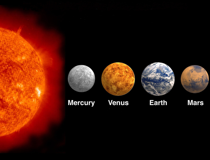
Terrestrial planets are Earth-like planets (in Latin, terra means Earth) made up of rocks or metals with a hard surface — making them different from other planets that lack a solid surface. Terrestrial planets also have a molten heavy metal core, few moons, and topological features such as valleys, volcanoes and craters. In our solar system, there are four terrestrial planets, which also happen to be the four closest to the sun: Mercury, Venus, Earth and Mars. During the creation of the solar system, there were likely more terrestrial planetoids, but they likely merged or were destroyed.
NASA's Kepler space observatory had discovered more than 1,000 confirmed alien planets — and thousands more possibilities — as of August 2015. Using the data from the telescope, scientists have calculated that there may be billions of Earth-like planets in the Milky Way galaxy! Kepler scientists also found that super-Earths — planets slightly larger than our own — are in the universe. If these super-Earths are rocky, it would make rocky planets a common phenomenon. However, not all of these are habitable;i.g some are too close or far from their parent star.
Rocky planets developed from small grains of dust that collided and stuck together to form pebbles, boulders, kilometer- and mile-sized planetesimals, and larger planetary embryos and protoplanets). They formed in the inner portion of the disk located closer to the developing Sun during the first 100 million years of the System's birth, where it was too warm for the four developing planets to form water and more volatile ices and gather up sufficiently in gravity so they might to hold onto the plentiful, but lightest gases of the Solar nebulae (hydrogen and helium) to become "gas giants." Although rocky (and icy protoplanets) formed in the Main Asteroid Belt, the early development of Jupiter prevented protoplanets like icy Ceres from collecting into larger planetary bodies.
Earth is the most hospitable to life. Mars may have supported life in the past, but there is no evidence that conditions have ever been life-friendly on Mercury or Venus. Each of the terrestrial planets has a central core made mostly of iron. The layer above the core is called the “mantle” and is usually made of silicate rocks. These are rocks rich in silicon and oxygen. 75% of Earth’s surface is covered in water. Both Mars and Earth have permanent polar ice caps. None of the terrestrial planets in our solar system have ring systems. Planetary scientists suspect that they may once have had rings that have since disappeared. There is one dwarf planet considered to be terrestrial-type world: Ceres. It has a rocky core and an outer mantle, with surface features such as craters and mountains.





